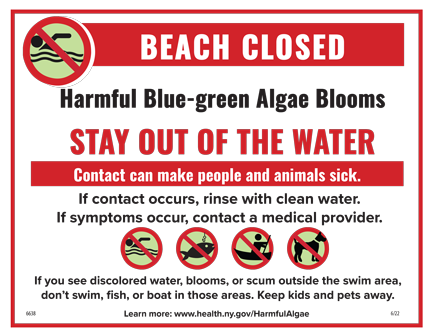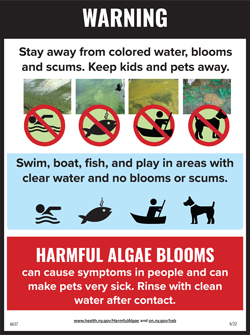Harmful Blue-green Algae Bloom Response for Beach Operators and Staff
Harmful Blue-green Algae Bloom Response for Beach Operators and Staff is available in Portable Document Format (PDF).
Operator Action Steps
These instructions are for beach operators and staff to help protect patrons from potentially harmful blue-green algae blooms (HABs).
- Monitor beach areas for suspicious blooms.
- Contact your local health department if a HAB is suspected.
- Close swim area and post signs to prohibit wading and swimming if suspicious algae is in the swim area.
- Post advisory signs if blooms are observed outside of the swim area.
- Inform staff when suspicious blooms are present, when the swim area is closed, and when advisories are in effect.
- Report symptoms of HAB exposure to your local health department.
What are blue-green algae?
Blue-green algae (cyanobacteria) are microscopic organisms that occur naturally in lakes, streams, and oceans. Under certain conditions they can form dense blooms called “HABs” that discolor the water or produce floating scums.
Why are HABs a concern?
Some HABs produce toxins, some do not. However, exposure to any HAB can cause health effects in people and animals if water with dense blooms is contacted, swallowed, or if airborne droplets are inhaled.
How do I recognize a HAB?
It could be a HAB if the water is blue-green, green, yellow, brown, red, has a paint-like appearance, or there is scum on the water surface.
What do beach operators and staff need to know?
- Beaches should be monitored for suspicious blooms.
- Blooms can appear and disappear rapidly, even in under an hour. Staff should be trained to identify suspicious blooms and take action to prevent people from being exposed.
- Beach patrons and staff should be notified whenever a suspicious bloom is present, the swim area is closed, or a HAB advisory is in effect.
- People and animals should avoid contact with any suspicious blooms because exposure can cause health effects.
What should beach operators and staff do if they suspect a HAB?
Contact your local health department immediately if you suspect a bloom anywhere on a waterbody with a regulated bathing beach. Health department staff will help confirm that the bloom is a HAB and provide signs to post to help prevent exposure.
If the bloom is within the swim area
Prohibit wading, swimming, and any water contact activities in the swim area and notify your local health department. Post closure signs at the beach and advisory signs at other shoreline access areas ( see below). Do not attempt to push the bloom away from the swim area or remove bloom material from the water.
If the bloom is outside the swim area
Advisory signs should be posted to inform patrons to protect themselves and their animals from contact with blooms. Staff should monitor the location of the bloom and if it moves into the swim area, water contact activities should be prohibited and a beach closure sign should be posted.
When can the swim area be re-opened?
Notify your local health department when the bloom is gone from the swim area. They will provide guidance for reopening the beach. A water sample from the swim area must be collected. Wading, swimming, and other water contact activities can resume if the results show that the water is clear of blooms and toxin levels are below a level of concern. Most HABs go away naturally, and can come and go in a short time period.
What are the health effects from exposure?
Potential health effects from HAB exposure include irritation of the skin, eyes, nose, throat, and respiratory tract. Swallowing water with HABs can also cause nausea, diarrhea, and vomiting. Ingesting water with high levels of toxins over long-time periods has also been associated with effects on the liver and nervous system.
Contact with low levels of blue-green algae (with no visible bloom) are not expected to cause health effects. However, some more sensitive people could experience mild symptoms such as skin, eye, or throat irritation; or allergic reactions.
What should you do after being exposed to a blooms?
- Rinse off with clean water immediately.
- Consider medical attention for symptoms such as nausea, vomiting or diarrhea; skin, eye or throat irritation, allergic reactions, or breathing difficulties.
- Report symptoms that may be related to exposure to suspicious blooms to your local health department.


